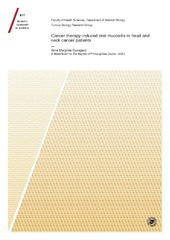Cancer therapy-induced oral mucositis in head and neck cancer patients
Permanent link
https://hdl.handle.net/10037/8171View/
Thesis introduction and appendix (PDF)
Assessment of Cancer Therapy-Induced Oral Mucositis Using a Patient-Reported Oral Mucositis Experience Questionnaire. Gussgard AM, Hope AJ, Jokstad A, Tenenbaum H, Wood R. Also available in PLoS ONE 2014; Volum 9 (3) (PDF)
Symptoms reported by head and neck cancer patients during radiotherapy and association with mucosal ulceration site and size: an observational study Gussgard AM, Jokstad A, Wood R, Hope AJ, Tenenbaum H. (Manuscript.) Published version available in PLoS ONE, June 10, 2015 (PDF)
Head and neck cancer patients experiencing radiation-induced mucositis - should the signs or the symptoms be measured? Gussgard AM, Jokstad A, Hope AJ, Wood R, Tenenbaum H. (Manuscript.) Published version, with altered title, available in Journal of the Canadian Dental Association, June 05, 2015 (PDF)
Entire thesis in one comprehensive file. (PDF)
Date
2015-06-17Type
Doctoral thesisDoktorgradsavhandling
Author
Gussgard, Anne MargreteAbstract
Background: Radiotherapy causes oral mucositis (OM) that is painful and disrupts eating, talking, social activities and general health. OM may even interrupt cancer therapy. Any intervention that can reduce OM will lead to improvement in treatment and quality of life for patients. It is essential to have a suitable tool to measure potentially effective and new treatments against OM.
Objective: To determine if the Patient Reported Oral Mucositis Symptom (PROMS) scale provides a more accurate tool for assessment of oral mucositis than conventional methods based solely on clinician-assessed recordings in patients receiving radiation for head and neck malignancy.
Methods: Fifty study participants were examined clinically once before radiotherapy and thereafter twice weekly during the course of their 6-7 weeks treatments and once again post radiotherapy. OM was evaluated clinically according to commonly used clinical assessment tools. The patient-reported OM symptoms were recorded on PROMS-questionnaires. The relationships between PROMS data and clinical data were appraised with Spearman rank correlation tests at the different time points, using robust repeated measures mixed linear models. ANOVA were applied for comparisons of changes of PROMS scale values upon transitions between different sizes of OM ulceration. Simple bivariate tests were used for comparison of characteristics of study participants.
Results: Thirty-three participants completed the study. Significant correlations (p<.001) were seen between PROMS scores and other clinical assessments of OM at a group level. The correlation between different signs and symptoms over all time points varied markedly on the individual level. The major change in PROMS scale values occurred upon transition from small to medium size of ulceration, rather than from medium to large. The characteristics of the study participants in different sub-cohorts defined by high and low correlations, high manifestations & minor complaint and low manifestations & major complaints, were comparable, except for age.
Conclusion: The relationship between patient-reported impairment of oral functions and mouth pain caused by OM ulceration is not linear, but rather more curvilinear. Therefore, future interventional studies should adopt less severe outcomes than maximum clinical OM scores as primary outcomes. Patient-reported outcomes (PROs) should be incorporated in any interventional studies regarding OM and the changes of PROs values should be measured on the intra-individual rather than on any inter-individual levels. The PROMS questionnaire may be a useful tool to augment clinical assessment of OM, and a feasible substitute assessment in situations where patients cannot endure oral examinations.
Publisher
UiT The Arctic University of NorwayUiT Norges arktiske universitet
Metadata
Show full item recordCollections
Copyright 2015 The Author(s)
The following license file are associated with this item:


 English
English norsk
norsk
